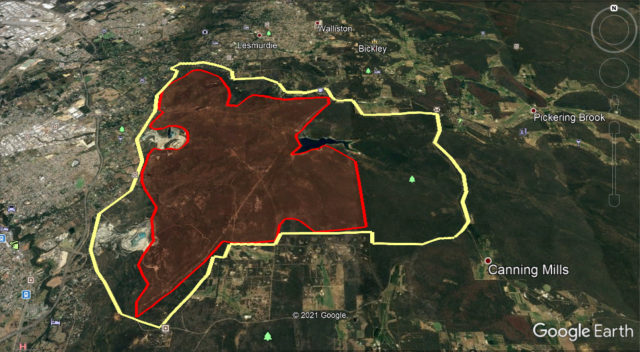About the program
A WA-first baiting program targeting European wasps, Vespula germanica, was implemented by the Department of Primary Industries and Regional Development (DPIRD) during its 2019-20 European wasp surveillance season. The baiting program was initiated after established methods to locate and destroy nests proved inadequate in the rugged, largely inaccessible bushland of the Darling Scarp.
The surveillance program covered over 4590 ha of continuous bushland from Lesmurdie to Martin, encompassing the Victoria Dam and Reservoir, to delineate areas of European wasp activity. Information from published interstate and international baiting programs was drawn upon to design and implement a targeted European wasp specific baiting program across 2500 ha.
This program comprised 257 baiting stations, distributed across a 300m grid, and ran from 6 March to 9 April 2020. The bait consisted of a mixture of raw Pink Ling fish and the insecticide Fipronil. The risk to non-target species was managed through mindful trap placement, monitoring and careful selection of bait media. Non-target species (such as bees) have displayed no interest in raw fish attractant or bait stations, therefore providing confidence that there were no impacts on bees or other beneficial insects. The unique scavenging behaviour of European wasps on carrion and animal protein allows it to be selectively baited, with negligible impacts to non-target species. Bait station design, deployment and removal prevented impacts on native wildlife or risk to drinking water resources.



Results
No European wasp activity was detected in the baiting area after the conclusion of the baiting program, nor for the remainder of the season. The effect of the baiting program and its ability to remove European wasps from this environment could not be fully evaluated until completion of the 2020-21 surveillance season, where intensive trapping of the area would substantiate if wasp activity remained. The 2020-21 season has now drawn to a close and surveillance trapping conducted in this area from December 2020 through to May 2021 found no evidence of European wasp activity.
This is an excellent result, and whilst it is a strong indicator that the species has been eradicated from the trial area, surveillance in the area will continue next season to monitor for new incursions and ensure no wasp nests have survived undetected. The implementation of a safe and effective baiting program was necessary in removing European wasps from this challenging environment and preventing them from gaining a permanent foothold in the region. The effectiveness and application of baiting programs will be evaluated to determine future use as part of an integrated pest management strategy. It is not proposed to replace the existing surveillance strategy for European wasps in WA.
European wasps are a reportable declared pest species in WA under the Biosecurity and Agricultural Management Act 2007. Control and eradication of this pest is undertaken by DPIRD.
Learn more
The Perth Hills and Darling Scarp supports large natural areas, including National and Regional Parks and Water Catchment areas. It is also a site of significant horticultural production, including mixed fruit orchards and vineyards. Apiarists provide pollination services and produce honey in these areas. Should European wasps establish in this region, their impacts would extend across social, environmental, and agricultural areas.
A baiting program with the intention to eradicate wasps from this terrain has never been attempted or required in WA previously, nor has a coordinated baiting program of this size been completed in Australia. Baiting to manage or suppress European wasps however is not an uncommon practice interstate and internationally. Baiting activities and pilot programs in New South Wales, Victoria, Tasmania and internationally all use a protein source (e.g. sardine, chicken, seafood, catfood etc.) laced with the insecticide Fipronil. See the 'External Links' section of this webpage for examples of these activities.
Acknowledgements
The success of the European wasp surveillance and eradication program relies on collaboration between the public, businesses, industry and government. The benefits of a successful program are shared by all. Completion of this time critical work would not have been possible without the collaborative efforts or assistance from the City of Kalamunda, Water Corporation, Department of Biodiversity, Conservation and Attractions (DBCA), the City of Gosnells and the surrounding community.
Particular acknowledgement goes to the City of Kalamunda's fire mitigation team who were integral in the deployment and monitoring of traps and bait stations throughout the challenging bushland terrain.


